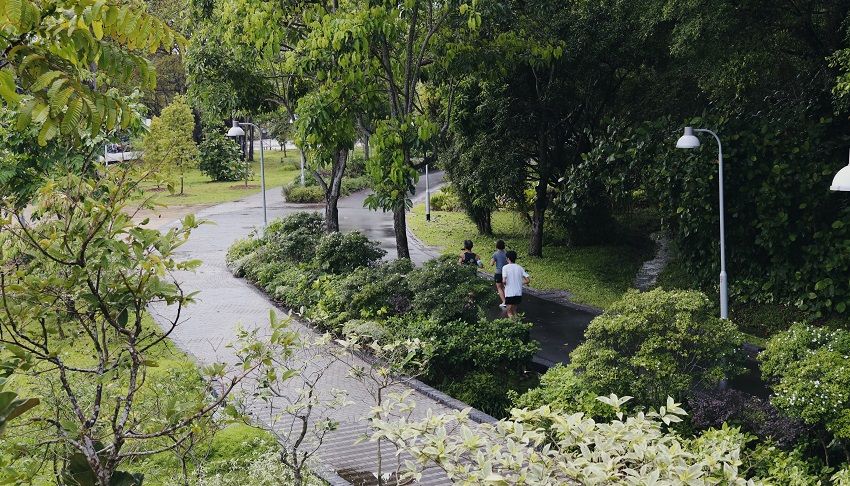Short walks and vegan food: the keys to a sustainable future
By Sean Nolan
Sustainability experts came together to discuss the next steps to tackling climate change.

Today, the challenge, and the tools to battle it, are better understood. Redesigning public spaces and IoT are some of the ways that Southeast Asian policy-makers can create future-ready sustainable societies.
Experts from the ‘Smart and sustainable: Transforming cities for the future’ webinar shared policy recommendations and exciting developments that are giving tree huggers something to be optimistic about.
These streets are made for walking
Singapore’s vehicles produce over a tenth of the nation’s total emissions. Almost a million vehicles traverse Singapore’s roads, producing 6.4 million tonnes of carbon dioxide, wrote The Straits Times.
An ideal solution to reducing these emissions is to create more walkable transport options, explained Kevin Hsu, Senior Assistant Director at the Centre for Liveable Cities. After all, how much land should really be devoted to automobile traffic and parking lots, he asked.
More than 50 cities including Boston, Cologne and Sydney have closed at least one automobile road, to give the public more space to walk. More walkability reduces the need for vehicles, and promotes physical activity, he said.
While some retailers fear road closures will harm business, increased foot traffic will actually boost spending, he suggested. These road closures and new walking lane policies were popular among citizens and could become permanent in their respective cities, he added.
City planners can encourage walking by creating “complete neighbourhoods”, Hsu shared. These neighbourhoods should be built so that housing, work, shops, healthcare, education and leisure are all accessible by foot or by bicycle, he explained.
As well as reducing the need for vehicles, these neighbourhoods will help local businesses and improve the community spirit through more neighbourly interactions, he adds.
Cultural and societal changes can also reduce the need for transport, added Andrey Berdichevskiy, Future of Mobility Solution Center Director at Deloitte. The development of new vegan food products is one example of this, he identified. Transitioning to a plant-based diet will reduce the emissions created by transporting meat.
The animal agriculture industry is responsible for about 14 to 18 per cent of global carbon dioxide emissions. Adopting plant based diets has the potential to reduce that by almost 73 per cent, Berdichevskiy shared.
Sensing a change to the environment
By adopting digital tools, cities can become more environmentally friendly, said Chew Men Leong, President Urban Solutions at ST Engineering. IoT sensors are being fitted on buildings as well as critical, transport and patient infrastructure, he identified.
This provides monitoring feedback. When combined with data analytics and AI, they can improve services and provide predictive maintenance, he said.
These sensors improve sustainability by keeping track of utility efficiency. For example, digital monitoring in water grids can identify leakages. IoT sensors in buildings can activate lights and air-conditioning based on human traffic, rather than running constantly, Chew added.
IOT, the cloud, 5G and the right data platforms will all help governments to ensure smoother travel, said Karen Chong, Country Manager at ServiceNow. Data collected from roadside sensors can help inform an intelligence traffic system, as one example.
Meanwhile, adopting the cloud allows governments to grow or shrink their computing abilities, said Ian Krieger, Director of Executive Advisory Services at ServiceNow. This ability reduces energy wastage and is ultimately beneficial for the environment, he explained.
The challenge facing Asia
Asia’s challenges show the importance of sustainable policies. The region faces issues in environmental as well as social sustainability, shares Dato’ Seri Maimunah Sharif, Executive Director at UN-Habitat.
The next major crisis will be the climate crisis, she warned. Extreme weather events, forest fires, and natural disasters are just some of the effects that nations are already seeing, Dato’ Seri Maimunah identified.
Investing in renewable energy generation, electric mobility, and monitored electricity grids are just some of the steps governments can take to prepare for the crisis. This will reduce carbon emissions, and build resilience to climate-related disasters, she noted.
The digital divide remains a challenge for achieving social sustainability and equality. At the end of 2020, the International Telecommunication Union estimated that more than half of the population in Asia and the Pacific Region remain offline, she said.
Governments should be investing in infrastructure to widen access to wireless networks, highlighted Dato’ Seri Maimunah. Public authorities should also undertake city-wide assessments of digital inclusion, ensuring that this issue doesn’t grow even further.
Climate change is a global problem, requiring global solutions. Governments have a responsibility to harness humanity’s understanding of climate change in order to address it. Improving urban walkability and using digital tools are a good first step.
Catch the full webinar here.